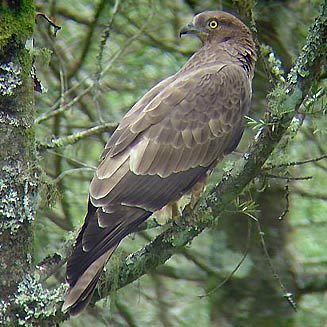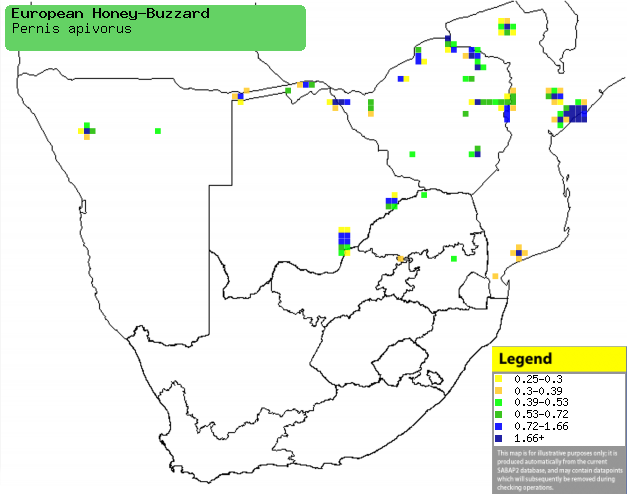|
Pernis apivorus (European
honey-buzzard, Honey buzzard)
Wespedief [Afrikaans]; Wespendief [Dutch]; Bondrée apivore
[French]; Wespenbussard [German]; Bútio-vespeiro [Portuguese]
Life
> Eukaryotes >
Opisthokonta
> Metazoa (animals) >
Bilateria >
Deuterostomia > Chordata >
Craniata > Vertebrata (vertebrates) > Gnathostomata (jawed
vertebrates) > Teleostomi (teleost fish) > Osteichthyes (bony fish) > Class:
Sarcopterygii (lobe-finned
fish) > Stegocephalia (terrestrial
vertebrates) > Tetrapoda
(four-legged vertebrates) > Reptiliomorpha > Amniota >
Reptilia (reptiles) >
Romeriida > Diapsida > Archosauromorpha > Archosauria >
Dinosauria
(dinosaurs) > Saurischia > Theropoda (bipedal predatory dinosaurs) >
Coelurosauria > Maniraptora > Aves
(birds) > Order: Falconiformes
> Family: Accipitridae
 |
|
|
European honey-buzzard, Magoebaskloof, South
Africa. [photo Trevor Hardaker ©] |
|
Distribution and habitat
Breeds from Scandinavia and western Siberia to the
Mediterranean, heading south in the non-breeding season to sub-Saharan Africa, from
Guinea-Bissau to eastern Sudan and Ethiopia south to southern Africa. Here it is
uncommon in patches of Zimbabwe, southern and central Mozambique, eastern
Botswana, the Caprivi Strip (Namibia), north-central Namibia and north-eastern
South Africa. It can occur in an well-wooded habitat, such as forest, woodland,
plantations and gardens.
|
 |
|
Distribution of European honey buzzard in southern Africa,
based on statistical smoothing of the records from first SA Bird Atlas
Project (©
Animal Demography unit, University of
Cape Town; smoothing by Birgit Erni and Francesca Little). Colours range
from dark blue (most common) through to yellow (least common).
See here for the latest distribution
from the SABAP2. |
Movements and migrations
The adults leave the breeding grounds in
August, followed by the juveniles in September, arriving in southern
Africa in late November and departing from April-May.
Food
It mainly eats insects, especially wasps and bees, doing
most of its foraging aerially or on the ground. The following food items have been recorded
in its diet:
- Arthropods
-
Hymenoptera (wasps, bees and ants)
- Belanogaster (paper wasps)
- Vespula germanica (Yellow jacket wasp)
- hornets taken from nests snatched off trees or huts
- bees
-
termites
- worms
-
spiders
- Plants
Threats
Not threatened, although it is severely persecuted when it
passes over the Mediterranean in its migration.
References
-
Hockey PAR, Dean WRJ and Ryan PG 2005. Roberts
- Birds of southern Africa, VIIth ed. The Trustees of the John Voelcker
Bird Book Fund, Cape Town.
|
